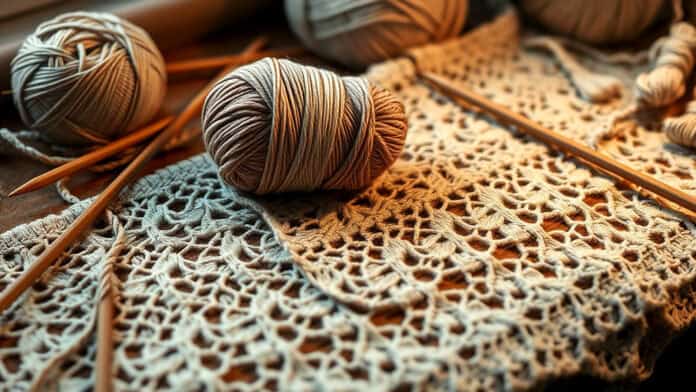Easy Lace Knitting Patterns For Beginners
Ready to dive into the world of lace knitting? You’ve landed in the right spot! With lace knitting patterns, even beginners can create stunning projects. These patterns are like magic, turning simple stitches into art. Start with a basic lace stitch, like a two-row repeat lace stitch. It’s a great way to ease into lace knitting. You’ll soon find yourself hooked, eager to try more. Picture making a cozy scarf or a delicate shawl. How about a lace knit sweater? The possibilities are endless. Whether you’re knitting a pretty lace stitch or mastering the lace columns stitch, there’s something here for everyone. Let’s embark on this knitting journey together!
Key Takeaways
- Start with a basic lace stitch. It’s perfect for beginners.
- Use the lace columns stitch for an easy and versatile design.
- Try the hearts lace stitch for simple yet pretty patterns.
- A lace knit sweater can be a stylish goal as you advance.
- Follow a repeat lace stitch to create stunning textures effortlessly.
Understanding Lace Patterns and Stitches
Exploring the stitches and patterns of lace reveals a rich tapestry of creativity. Dive into easy lace knitting patterns for beginners by focusing on stitches like the fern lace stitch. This offers a blend of simplicity and elegance. The pretty lace stitch works wonders in adding flair to your projects. Consider incorporating them into a knit sweater pattern for a touch of sophistication.
For those venturing into knitting, understanding the art of lace is akin to painting with yarn. Think of each stitch as a brushstroke, creating beautiful, textured designs. The famous fern lace stitch can add a unique twist to your creations.
Here’s a list of techniques and tips:
- Start with a simple two-row repeat.
- Incorporate yarn overs for openwork effects.
- Experiment with different yarn textures.
- Use stitch markers for complex designs.
- Try reversible patterns.
- Maintain even tension.
- Block your finished piece for a polished look.
- Choose lightweight yarns for summer garments.
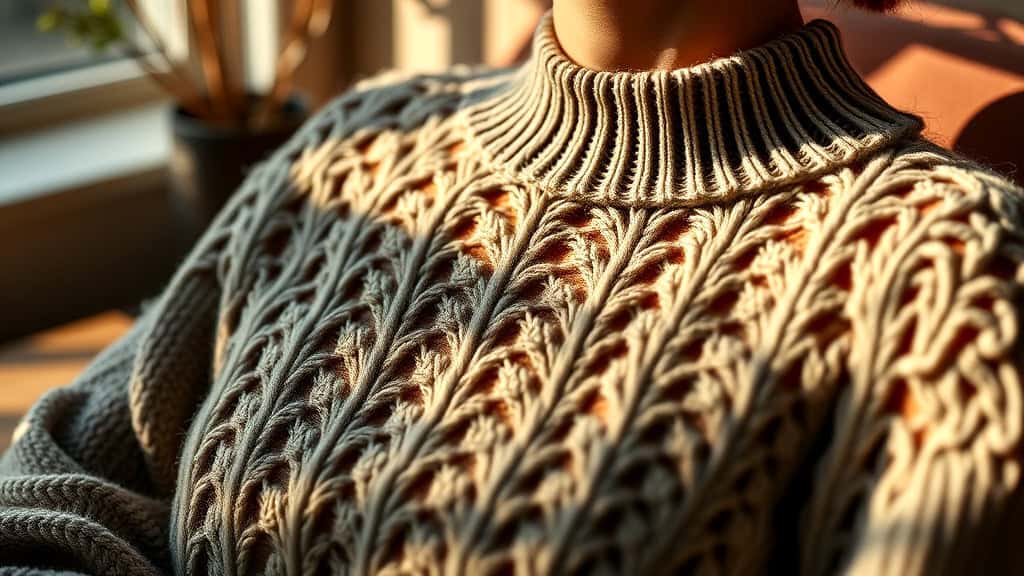
Essential Tools for Lace Knitting
Selecting the right gear can make or break your lace knitting experience. For those starting with Easy Lace Knitting Patterns For Beginners, a few essentials are key. First off, consider bamboo needles, which offer a smooth glide without slipping. Pair these with light, breathable yarns like cotton or linen for easy handling.
Needles should match your yarn’s weight; too large and you’ll have a lace pattern that’s all over the place, too small, and it could end up tight as a drum. Yarn overs and knitting stitches together are the bread and butter here.
A row counter might also save your bacon, keeping track of where you are in your lace knit project. A simple knit sweater pattern can become a masterpiece with the right tools. Lastly, keep a crochet hook handy for those pesky dropped stitches.
| Tool | Purpose | Recommended For | Note |
|---|---|---|---|
| Bamboo Needles | Smooth knitting | Beginners | Light, easy handling |
| Cotton or Linen Yarn | Lightweight and breathable | Summer projects | Good drape |
| Row Counter | Keeps track of rows | Complex patterns | Helps maintain pattern |
| Crochet Hook | Fixes dropped stitches | Lace knitting | Essential for quick fixes |
| Yarn Over Technique | Creates lace effect | All lace projects | Basic skill to master |
Tips for Choosing Yarn and Needles
Selecting the right yarn and needles can make your easy lace knitting patterns for beginners a breeze. Think about the drape and texture you’re aiming for. Different yarn blends like wool and silk can offer varied effects. Wool is warm, while silk adds a touch of luxury.
Needle size is crucial. It should match the thickness of your yarn to create a balanced lace pattern. Too tight, and it might look like a tangled mess. Too loose, and you’ll end up with a spider web.
Experimenting is key. Try a few combinations before settling. Ever tried a fancier lace stitch? It can add some flair to your piece. Imagine a lace knit sweater that feels as good as it looks.
The journey isn’t just about knitting; it’s about crafting a delightful experience. Whether you’re working on a pretty lace stitch or a simple knit lace, enjoy the process.
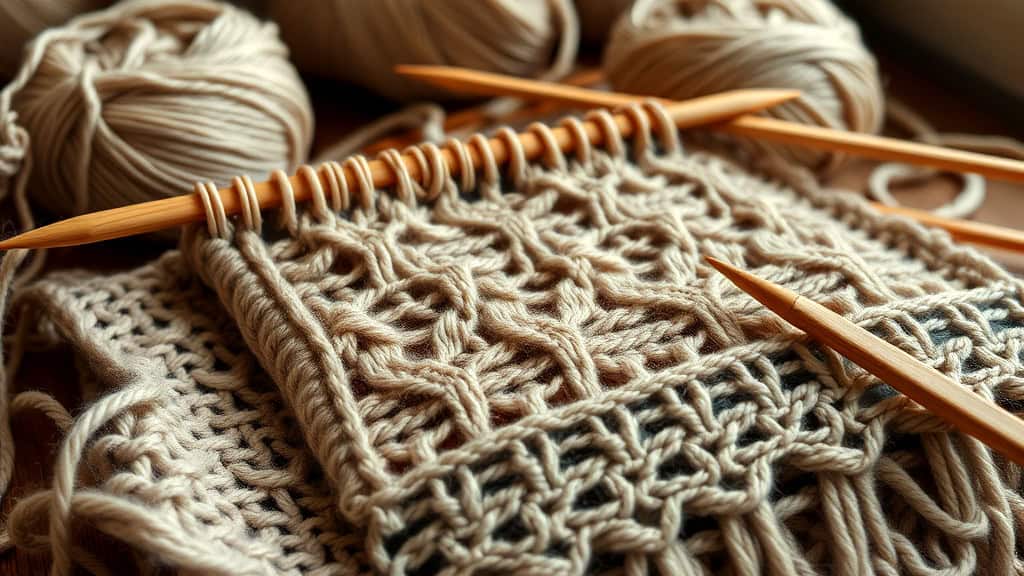
How to Knit a Simple Lace Stitch
Starting with a basic design can make knitting a fancier lace stitch feel approachable. Begin with a simple two-row lace pattern. Cast on an even number of stitches. Use yarn overs and knit two together. This creates an airy effect.
- Cast on an even number of stitches.
- Row 1: Knit 1, yarn over, knit two together, repeat across the row.
- Row 2: Purl all stitches.
- Repeat these two rows to create the pattern.
- Remember to maintain constant tension for even stitches.
- Try this technique with different yarns for varied effects.
- Block your finished piece for a polished look.
- Add stitch markers to easily track your progress.
Fancy trying something new? How about a fern lace stitch? It offers a lovely leafy pattern. Or explore a hearts lace stitch for a romantic touch. These easy knit lace designs can transform a simple project into something special.
Step-by-Step: Two-Row Lace Pattern
Let’s explore how to knit a basic two-row lace pattern. This easy lace knitting pattern for beginners involves alternating two simple rows. The first row is filled with knit stitches and yarn overs, creating those delicate holes. The second row, a plain purl, balances out the texture. Remember to keep your tension even; this helps maintain the pattern’s elegance.
Start with a fancier lace stitch by adding a twist. After mastering this, consider incorporating it into a knit sweater pattern for a touch of sophistication. This approach not just enhances your skills but also boosts your project portfolio.
A tip? Use different yarns to make your lace designs pop. Each can give your pattern a unique flair. Try a wool blend for warmth or cotton for summer vibes. With practice, you’ll see how these simple techniques can create easy knit lace.
| Step | Row Type | Key Techniques | Tips |
|---|---|---|---|
| 1 | Knit | Yarn Over | Maintain tension |
| 2 | Purl | Plain Purl | Relax hands |
| 3 | Knit | Yarn Over | Steady hands |
| 4 | Purl | Plain Purl | Breathe easy |
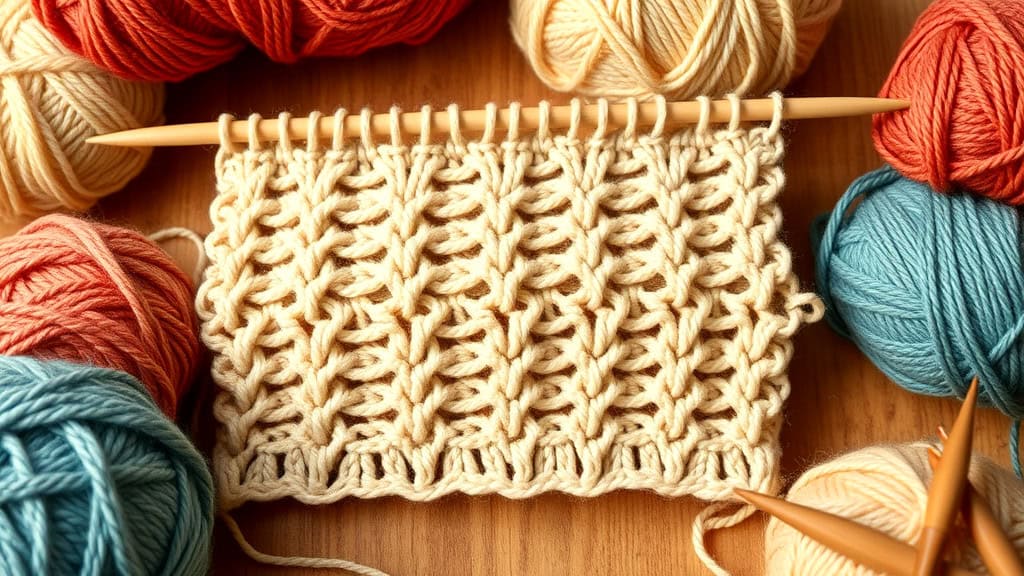
Mastering the Four-Row Lace Repeat
Taking on a four-row lace repeat offers a fresh challenge while still being approachable. This lace pattern has a rhythm that beginners can enjoy. It introduces a bit of complexity but remains accessible.
A typical pattern involves plain purl rows interspersed with more intricate stitches. This approach gives your mind a chance to rest while still making progress. The result? A stunning, textured design that looks more advanced than it is.
A good tip when tackling this is to use stitch markers. They help keep track of repeats and avoid mistakes. Try knitting an easy knit lace swatch first. It provides a low-pressure way to get comfortable with the sequence.
Once confident, you’ll be ready to incorporate a fancier lace stitch or even the lovely hearts lace stitch into your projects. Dip your toes into these waters and discover the satisfaction of creating something enchanting.
Creating a Lace Scarf: A Beginner Project
Crafting a lace scarf is a fantastic beginner project, providing a taste of intricate design without overwhelming complexity. A simple lace pattern can transform a plain scarf into a masterpiece. Start by selecting a light, breathable yarn like bamboo or cotton. They are perfect for warmer weather and add a delicate touch. Choose needles that match your yarn’s weight for the best results.
For a basic project, try an easy knit lace technique. This involves straightforward stitches like yarn overs and simple decreases. If you want to add flair, incorporate a fancier lace stitch to elevate your piece. Keep your tension consistent, and you’ll see your scarf coming together beautifully.
Don’t forget to block your finished scarf. It helps the lace design open up and lay flat, showcasing its elegance.
| Yarn Type | Recommended Needle Size | Project Suitability |
|---|---|---|
| Bamboo | 3.5mm – 4mm | Lightweight Scarves |
| Cotton | 4mm – 5mm | Summer Accessories |
| Linen | 3mm – 4mm | Breathable Projects |
- Choose your yarn and needles wisely.
- Practice with a small swatch first.
- Use stitch markers to track rows.
- Keep tension consistent for uniformity.
- Block the finished piece for a polished look.
Easy Lace Columns Stitch Technique
The technique for creating lace columns offers endless possibilities for beginners. This four-row repeat is perfect for adding a touch of elegance to scarves and tops. Start with your favorite yarn, ensuring your needle size matches its thickness. This will help your stitches stay neat and tidy. Now, let’s focus on the pattern itself: the first row is all about setting the foundation. The second introduces fancy lace stitches that elevate your design. Remember to keep your tension consistent. By the third row, you’ll see the pattern emerging, like a hidden treasure chest revealing its secrets. The fourth row solidifies the design and is a breeze to knit. As you practice, consider visiting Garnstudio’s collection for more pattern inspiration. Keep knitting, and you’ll soon create beautiful lace pieces that dazzle like a summer sunset.
Pretty Lace Patterns for Knitting Sweaters
Creating lace patterns for sweaters adds a touch of whimsy. They often use lightweight yarns like bamboo or linen. These patterns offer a delicate texture, perfect for seasonal wear. For beginners, starting with Easy Lace Knitting Patterns For Beginners can simplify the process. One popular design is the Cat’s Paw Eyelets, which brings a playful detail to any garment.
When selecting a pattern, consider the drape and weight of your yarn. Experiment with different fibers such as silk or cashmere for varied results. Choosing the right needle size is equally crucial to maintain the lace pattern’s integrity.
Below is a table showcasing some beginner-friendly patterns:
| Pattern Name | Yarn Type | Difficulty | Needle Size |
|---|---|---|---|
| Cat’s Paw Eyelets | Bamboo | Beginner | US 7 |
| Simple Waves | Cotton | Beginner | US 6 |
| Daisy Chain | Linen | Easy | US 8 |
| Open Diamonds | Wool | Easy | US 5 |
| Feather Touch | Silk | Beginner | US 9 |
- Select a pattern that matches your skill level.
- Choose lightweight yarn for a breezy feel.
- Experiment with various needle sizes.
- Use stitch markers to track complex patterns.
- Consider adding fancy lace stitches for added flair.
- Keep tension consistent throughout.
- Block finished pieces for a polished finish.
For more inspiration, Mama in a Stitch’s Hooded Knit Adak Wrap Pattern offers a beautiful example.
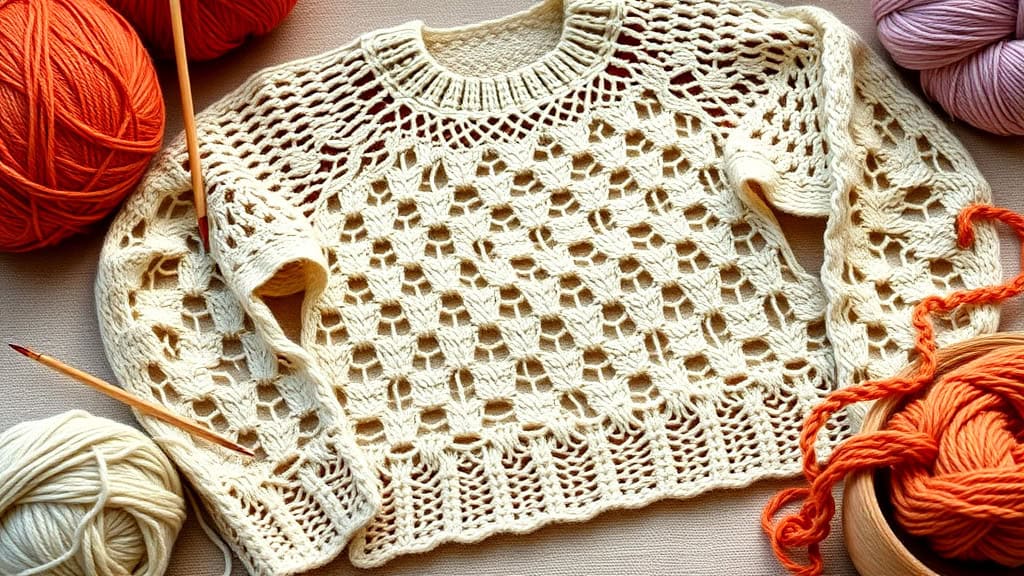
Simple Hearts Lace Stitch for Beginners
Crafting simple heart designs can be an exciting introduction for those diving into easy lace knitting patterns for beginners. This pattern captures a delightful heart motif using basic techniques, making it manageable yet satisfying. Start with a few yarn overs and straightforward decreases. Before you know it, the tiny hearts begin to appear as if by magic.
For anyone who’s knit a lace shawl, this pattern is a delightful twist. It’s like adding a sprinkle of sugar to your morning coffee—simple yet transforming. You won’t need fancy lace stitches or complex charts here. Just a bit of patience and some practice.
Feeling adventurous? Explore how others incorporate similar motifs into larger projects. For instance, King & Eye has a summer tank top knitting pattern with playful lace detailing. It’s an excellent example of how a basic lace technique can evolve into something more elaborate and stylish.
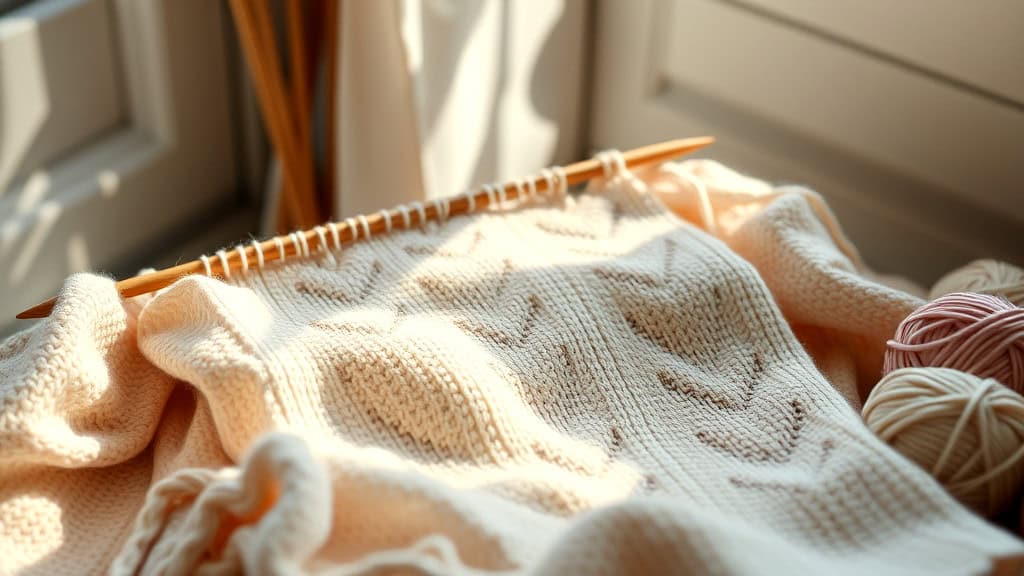
Knit a Lace Shawl in Easy Steps
Creating a lace shawl is a delightful journey that unfolds step by step. Begin by selecting a delicate yarn that complements your chosen design. Choose needles that suit your yarn’s thickness for a harmonious outcome. Start with a familiar pattern using basic yarn overs and decreases. These are the building blocks of your masterpiece. Once you have your essentials, cast on stitches and follow the sequences.
The charm lies in the repetition, much like a soothing rhythm. Don’t rush; cherish each row as it brings you closer to the end. To keep track, use stitch markers. These tiny helpers prevent mishaps in your pattern.
As your shawl grows, witness the elegance and beauty emerging. Finally, block your finished piece. This step elevates your creation, revealing its full allure. Each stage is a brushstroke in a painting, culminating in a shawl that’s both functional and a testament to your skills.
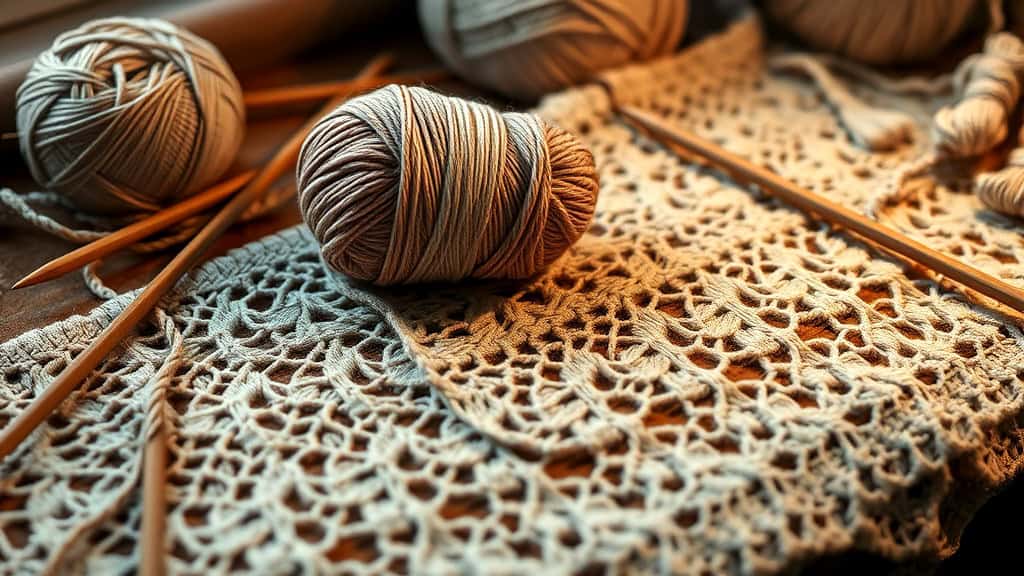
Top 5 Lace Knitting Tips for Success
If you’re looking for success in lace knitting, here are five key tips to help you excel. First, practice makes perfect—just like learning a new dance move. Try simple patterns first, like those in easy lace knitting patterns for beginners. They offer a great start without overwhelming you. Next, stay organized with stitch markers. These tiny lifesavers help keep track of your rows. Third, tension matters. Keep it consistent to avoid uneven results. Fourth, don’t skimp on blocking. It’s like ironing clothes—it enhances the final look. Lastly, always have a backup plan. Keep an extra ball of yarn handy for any unexpected snags. These strategies will make your knitting journey smoother and more fun. Remember, even the most intricate designs started as simple threads. Celebrate small wins and keep those needles clicking!
Conclusion
Embarking on the lace knitting journey is like opening a door to endless creativity. From simple two-row patterns to more intricate four-row repeats, each step you take refines your skills. Remember, practice makes perfect, so don’t be afraid of mistakes. They are just knots in your learning yarn.
Choosing the right tools and materials is crucial. Experiment with different yarns and needle sizes to find your sweet spot. Whether knitting a scarf, shawl, or sweater, each project is a chance to improve. Keep these tips handy, and soon, you’ll create stunning lace pieces. Enjoy the process, and happy knitting!
FAQ
- What is the simplest lace knitting pattern for beginners?
A two-row lace pattern is a fantastic starting point. It involves basic techniques like yarn overs and knitting two stitches together. Easy to memorize and great for building confidence!
- Which yarn is best for lace knitting?
Lightweight yarns like bamboo, cotton, or linen are ideal. They provide breathability and drape well. For a bit of luxury, try silk or cashmere blends!
- How do I keep my lace scarf edges from curling?
Adding a clean edge can prevent those pesky curls. Competitors often suggest techniques like garter stitch borders. It not just looks neat but also adds structure.
- What needle size should I use for lace knitting?
Choose a needle size that matches your yarn thickness. The lace pattern should be open yet not floppy. Experiment a bit to find the sweet spot!
- How do I finish my lace project professionally?
Blocking is your best friend! It helps shape and enhance the lace pattern. Consistent tension and stitch markers also aid in achieving a polished look.

